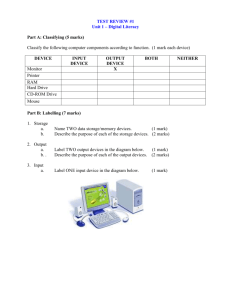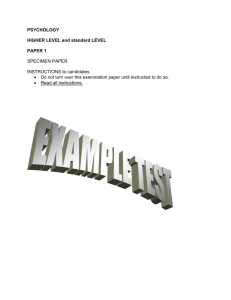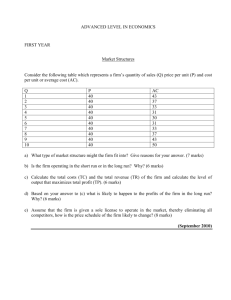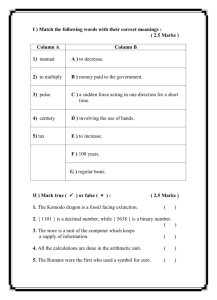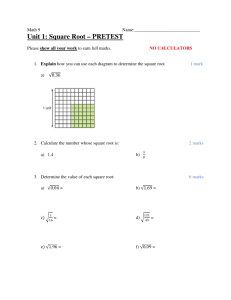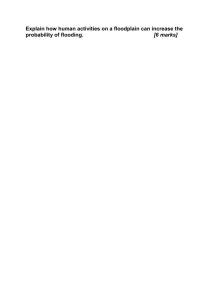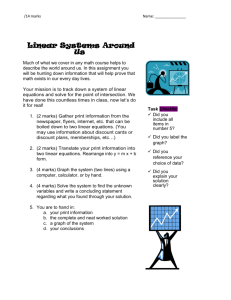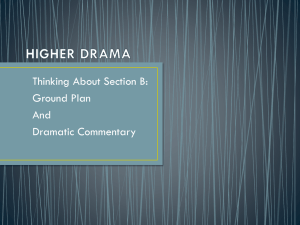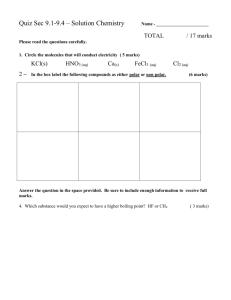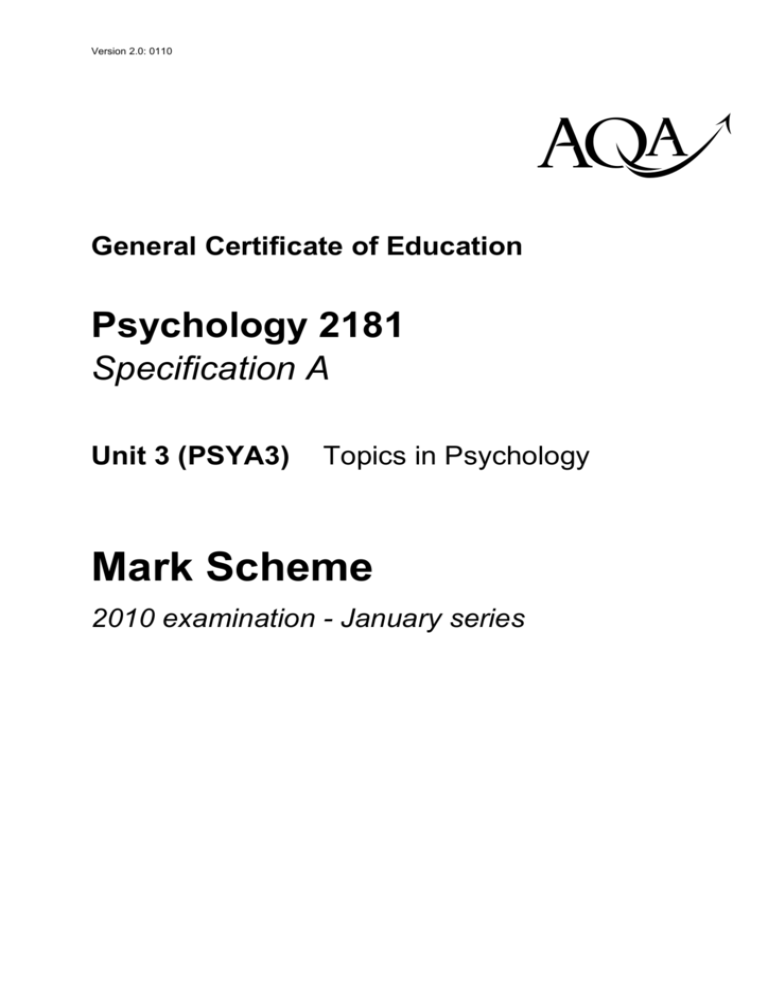
Version 2.0: 0110
klm
General Certificate of Education
Psychology 2181
Specification A
Unit 3 (PSYA3)
Topics in Psychology
Mark Scheme
2010 examination - January series
Mark schemes are prepared by the Principal Examiner and considered, together with the
relevant questions, by a panel of subject teachers. This mark scheme includes any
amendments made at the standardisation meeting attended by all examiners and is the scheme
which was used by them in this examination. The standardisation meeting ensures that the
mark scheme covers the candidates’ responses to questions and that every examiner
understands and applies it in the same correct way. As preparation for the standardisation
meeting each examiner analyses a number of candidates’ scripts: alternative answers not
already covered by the mark scheme are discussed at the meeting and legislated for. If, after
this meeting, examiners encounter unusual answers which have not been discussed at the
meeting they are required to refer these to the Principal Examiner.
It must be stressed that a mark scheme is a working document, in many cases further
developed and expanded on the basis of candidates’ reactions to a particular paper.
Assumptions about future mark schemes on the basis of one year’s document should be
avoided; whilst the guiding principles of assessment remain constant, details will change,
depending on the content of a particular examination paper.
Further copies of this Mark Scheme are available to download from the AQA Website: www.aqa.org.uk
Copyright © 2010 AQA and its licensors. All rights reserved.
COPYRIGHT
AQA retains the copyright on all its publications. However, registered centres for AQA are permitted to copy material
from this booklet for their own internal use, with the following important exception: AQA cannot give permission to
centres to photocopy any material that is acknowledged to a third party even for internal use within the centre.
Set and published by the Assessment and Qualifications Alliance.
The Assessment and Qualifications Alliance (AQA) is a company limited by guarantee registered in England and Wales (company number 3644723) and a registered charity (registered charity number 1073334).
Registered address: AQA, Devas Street, Manchester M15 6EX
Dr Michael Cresswell Director General
Psychology (PSYA3) - AQA GCE Mark Scheme 2010 January series
PSYA3: Topics in Psychology
BIOLOGICAL RHYTHMS AND SLEEP
1
(a)
Total for this question: 25 marks
Outline one example of a circadian rhythm.
(4 marks)
AO1 = 4 marks Outline of one circadian rhythm
Circadian rhythms have a 24 hour periodicity, and include the sleep/waking cycle and body
temperature. Candidates are likely to outline the sleep-waking cycle. Besides correctly
identifying the rhythm, an outline might include reference to the role of endogenous body clocks
and external zeitgebers such as light. However any material relevant to the sleep-waking cycle
would be creditworthy. This section should be marked bearing in mind time constraints.
AO1 Mark bands
4 marks
3-2 marks
1 mark
0 marks
(b)
(i)
Outline is reasonably thorough, accurate and coherent
Outline is limited, generally accurate and reasonably coherent
Outline is weak and muddled
No creditworthy material
Outline one or more explanations for sleep disorders (eg insomnia, sleep walking,
narcolepsy).
(5 marks)
AO1 = 5 marks Outline of one or more explanations for sleep disorders
There are a variety of explanations for insomnia, including basic dysregulation of biological
rhythms and a range of secondary factors; these may include apnoea, psychological and
medical conditions, and personality factors.
For narcolepsy there is clear evidence implicating genetics and the neurotransmitter orexin
(also known as hypocretin); description of symptoms is not credit-worthy unless linked to
explanations eg REM phenomena leaking into consciousness.
Sleepwalking – this is a parasomnia, occurring in NREM sleep. There is no clear biological
explanation beyond the relationship with NREM. Psychodynamic approaches emphasise the
leakage of dream content from REM into NREM sleep ie it is an acting out of dream imagery.
AO1 Mark bands
5 – 4 marks
Outline is reasonably thorough, accurate and coherent.
3 – 2 marks
Outline is limited, generally accurate and reasonably coherent.
1 mark
Outline is weak and muddled.
0 marks
No creditworthy material.
3
Psychology (PSYA3) - AQA GCE Mark Scheme 2010 January series
(b)
(ii)
Evaluate one or more explanations for sleep disorders
AO2/3 = 16 marks
(16 marks)
Analysis and evaluation of one or more explanations
Although unlikely, candidates need not focus on the explanations outlined in (b)(i). Research
studies can be used to support a role for eg apnoea or personality factors in insomnia.
Successful treatments (eg positive pressure masks or CBT) can be used to support
explanations. Candidates may comment on the difficulty of isolating key variables.
There are many studies on dogs and other animals supporting a role for genetics and orexin in
narcolepsy. These raise issues of extrapolation and generalisation. There are some human
studies on genetic bases and the role of orexin. Candidates may also comment on the failure of
pharmacological treatments as a limitation of the biological approach, and also its reductionist
nature.
With sleepwalking the psychodynamic approach can be criticised in terms of its speculative and
untestable nature. Such commentary need not be explicitly linked to the explanation to earn
credit, but would not earn marks beyond ‘rudimentary’.
Indicative issues/debates in the context of explanations for sleep disorders, depending upon the
explanation evaluated: use of animals in research; reductionism and its strengths and
limitations; alternative approaches, such as the biological and psychodynamic; ethical issues
(use of animals); nature-nurture (brain mechanisms v. environmental factors).
Evaluation of research is creditworthy, but to gain good marks the implications for explanations
need to be made clear; other material relevant to How Science Works might include analysis
and interpretation of data; accurate communication of ideas; applications and implications of
scientific findings (eg links between explanations and treatments); the tentative nature of
scientific knowledge.
AO2/3 Mark Bands
16-13 marks Effective
Evaluation/commentary demonstrates sound analysis, understanding and interpretation.
The answer is well focused and shows coherent elaboration and/or a clear line or argument.
Issues/debates/approaches are used effectively.
Ideas are well structured and expressed clearly and fluently. Consistently effective use of
psychological terminology. Appropriate use of grammar, punctuation and spelling.
12-9 marks Reasonable
Evaluation/commentary demonstrates reasonable analysis and understanding.
The answer is generally focused and shows reasonable elaboration and/or a line of argument is
evident.
Issues/debates/approaches are used in a reasonably effective manner.
Most ideas appropriately structured and expressed clearly. Appropriate use of psychological
terminology. Minor errors of grammar, punctuation and spelling only occasionally compromise
meaning.
8-5 marks Basic
Evaluation/commentary demonstrates basic, superficial understanding.
The answer is sometimes focused and shows some evidence of elaboration.
Superficial reference may be made to issues/debates/approaches.
Expression of ideas lacks clarity. Limited use of psychological terminology. Errors of grammar,
punctuation and spelling are intrusive.
4
Psychology (PSYA3) - AQA GCE Mark Scheme 2010 January series
4-1 marks Rudimentary
Evaluation/commentary is rudimentary, demonstrating little understanding.
The answer is weak, muddled and incomplete. Material is not used effectively and may be
mainly irrelevant.
If reference is made to issues/debates/approaches, it is muddled and inaccurate.
Deficiency in expression of ideas results in confusion and ambiguity. The answer lacks
structure, often merely a series of unconnected assertions. Errors of grammar, punctuation and
spelling are frequent and intrusive.
0 marks
No creditworthy material is presented.
PERCEPTION
2
Total for this question: 25 marks
Discuss the nature-nurture debate in relation to explanations of perceptual development.
(25 marks)
AO1 = 9 marks Outline of the nature-nurture debate in relation to explanations of perceptual
development
AO1 marks can be earned through a description of the nature-nurture debate and an outline of
relevant research studies. These can be taken, for instance, from classic and modern research
into the development of perceptual abilities (Fantz, Gibson & Walk etc), distortion studies, and
cross-cultural work. The question is open, and research using non-human animals, such as
Blakemore’s work on the cat visual cortex, is creditworthy. However the focus of the question is
on the nature-nurture debate, and any studies outlined must be explicitly shaped to the debate.
Gibson and Gregory must be used effectively in relation to perceptual development and the
nature-nurture debate to earn marks in the top two bands. Otherwise the maximum mark would
be 4.
AO1 Mark Bands
9-8 marks Sound
Knowledge and understanding are accurate and well detailed.
A good range of relevant material has been selected. There is substantial evidence of breadth
and depth. Organization and structure of the answer are coherent.
7-5 marks Reasonable
Knowledge and understanding are generally accurate and reasonably detailed.
A range of relevant material has been selected. There is evidence of breadth and/or depth.
Organisation and structure of the answer are reasonably coherent.
4-3 marks Basic
Knowledge and understanding are basic/relatively superficial.
A restricted range of material has been presented.
Organisation and structure of the answer are basic.
2-1 marks Rudimentary
Knowledge and understanding are rudimentary and may be muddled and/or inaccurate.
The material presented may be very brief or largely irrelevant.
Lacks organization and structure.
0 marks
No creditworthy material.
5
Psychology (PSYA3) - AQA GCE Mark Scheme 2010 January series
AO2/3 = 16 marks Analysis and evaluation of the nature-nurture debate in relation to
explanations of the perceptual development
There are many accessible and relevant studies supporting one or other side of the debate, and
effective use of findings and their implications would be a key aspect of accessing AO2 marks.
For marks in the top two bands there must be a sustained critical commentary on the naturenurture debate. Overall commentary on the interaction of nature and nurture in perceptual
development would be creditworthy. Evaluation could also include the problem of extrapolating
from non-human animals and cultural bias.
Indicative issues/debates/approaches in the context of the nature-nurture debate; ethical issues
(eg studies in infants, non-human animals); cross-cultural research, including cultural bias in
research and cultural differences in perceptual development; methodology in developmental
psychology; the biological approach.
Evaluation of research is creditworthy, but to gain good marks the implications for explanations
need to be made clear. Other material relevant to How Science Works might include the
analysis and interpretation of data; the communication of ideas; implications of scientific
findings.
AO2/3 Mark Bands
16-13 marks Effective
Evaluation/commentary demonstrates sound analysis, understanding and interpretation.
The answer is well focused and shows coherent elaboration and/or a clear line of argument.
Issues/debates/approaches are used effectively.
Ideas are well structured and expressed clearly and fluently. Consistently effective use of
psychological terminology. Appropriate use of grammar, punctuation and spelling.
12-9 marks Reasonable
Evaluation/commentary demonstrates reasonable analysis and understanding.
The answer is generally focused and shows reasonable elaboration and/or a line of argument is
evident.
Issues/debates/approaches are used in a reasonably effective manner.
Most ideas appropriately structured and expressed clearly. Appropriate use of psychological
terminology. Minor errors of grammar, punctuation and spelling only occasionally compromise
meaning.
8-5 marks Basic
Evaluation/commentary demonstrates basic, superficial understanding.
The answer is sometimes focused and shows some evidence of elaboration.
Superficial reference may be made to issues/debates/approaches
Expression of ideas lacks clarity. Limited use of psychological terminology. Errors of grammar,
punctuation and spelling are intrusive.
4-1 marks Rudimentary
Evaluation/commentary is rudimentary, demonstrating little understanding.
The answer is weak, muddled and incomplete. Material is not used effectively and may be
mainly irrelevant.
If reference is made to issues/debates/approaches, it is muddled and inaccurate.
Deficiency in expression of ideas results in confusion and ambiguity. The answer lacks
structure, often merely a series of unconnected assertions. Errors of grammar, punctuation and
spelling are frequent and intrusive.
0 marks
No creditworthy material is presented.
6
Psychology (PSYA3) - AQA GCE Mark Scheme 2010 January series
RELATIONSHIPS
3
Total for this question: 25 marks
‘To put it at its most basic, women want resources and men want to spread their genes.’
Discuss the evolutionary approach to explaining parental investment in humans (eg sex
differences, parent-offspring conflict).
(25 marks)
AO1 = 9 marks
Outline of evolutionary explanations.
Triver’s parental investment theory is likely to provide the basis for AO1 marks. This can be
linked to descriptions of differences in mate selection and parental behaviour between males
and females. Further considerations could include anisogamy, parent-offspring conflict and
cuckoldry. Later developments, such as Buss and Schmitt’s sexual strategies approach, would
also be relevant, but whatever explanations are presented AO1 marks will depend upon the
focus and understanding demonstrated in the answer. Overarching evolutionary explanations,
such as the selfish-gene approach, may only earn AO1 marks if the relevance to parental
investment is explicit. The question is on parental investment, and material on other aspects of
relationships, is unlikely to earn marks.
Description of relevant research evidence would be another route to AO1 marks, although
studies must be explicitly linked to parental investment.
AO1 Mark Bands
9-8 marks Sound
Knowledge and understanding are accurate and well detailed.
A good range of relevant material has been selected. There is substantial evidence of
breadth/depth. Organization and structure of the answer are coherent.
7-5 marks Reasonable
Knowledge and understanding are generally accurate and reasonably detailed.
A range of relevant material has been selected. There is evidence of breadth and/or depth.
Organisation and structure of the answer are reasonably coherent.
4-3 marks Basic
Knowledge and understanding are basic/relatively superficial.
A restricted range of material has been presented.
Organisation and structure of the answer are basic.
2-1 marks Rudimentary
Knowledge and understanding are rudimentary and may be muddled and/or inaccurate.
The material presented may be very brief or largely irrelevant.
Lacks organization and structure.
0 marks
No creditworthy material.
AO2/3 = 16 marks
Analysis and evaluation of evolutionary explanations of parental
investment in humans
The research of Buss and others on gender differences in mate preferences in the modern day
provides relevant evidence on evolutionary explanations. Further commentary could include
cultural shifts over time, such as the problem of non-heterosexual relationships, changes in
male and female attitudes to relationships and parental investment.
7
Psychology (PSYA3) - AQA GCE Mark Scheme 2010 January series
Indicative issues/debates/approaches in the context of the evolutionary approach: evolutionary
psychology (sociobiology) and alternative approaches; evolutionary reductionism; cultural
bias/differences in studies of parental investment; gender bias/differences in studies of parental
investment; free will and determinism.
Evaluation of research is creditworthy, but to gain good marks the implications for explanations
need to be made clear. Other material relevant to How Science Works might include
implications for society of evolutionary findings and ideas; analysis and interpretation of data;
communication of ideas.
AO2/3 Mark bands
16-13 marks Effective
Evaluation/commentary demonstrates sound analysis, understanding and interpretation.
The answer is well focused and shows coherent elaboration and/or a clear line or argument.
Issues/debates/approaches are used effectively.
Ideas are well structured and expressed clearly and fluently. Consistently effective use of
psychological terminology. Appropriate use of grammar, punctuation and spelling.
12-9 marks Reasonable
Evaluation/commentary demonstrates reasonable analysis and understanding.
The answer is generally focused and shows reasonable elaboration and/or a line of argument is
evident.
Issues/debates/approaches are used in a reasonably effective manner.
Most ideas appropriately structured and expressed clearly. Appropriate use of psychological
terminology. Minor errors of grammar, punctuation and spelling only occasionally compromise
meaning.
8-5 marks Basic
Evaluation/commentary demonstrates basic, superficial understanding.
The answer is sometimes focused and shows some evidence of elaboration.
Superficial reference may be made to issues/debates/approaches.
Expression of ideas lacks clarity. Limited use of psychological terminology. Errors of grammar,
punctuation and spelling are intrusive.
4-1 marks Rudimentary
Evaluation/commentary is rudimentary, demonstrating little understanding.
The answer is weak, muddled and incomplete. Material is not used effectively and may be
mainly irrelevant.
If reference is made to issues/debates/approaches, it is muddled and inaccurate.
Deficiency in expression of ideas results in confusion and ambiguity. The answer lacks
structure, often merely a series of unconnected assertions. Errors of grammar, punctuation and
spelling are frequent and intrusive.
0 marks
No creditworthy material is presented.
8
Psychology (PSYA3) - AQA GCE Mark Scheme 2010 January series
AGGRESSION
4
Total for this question: 25 marks
Discuss explanations of institutional aggression.
AO1 = 9 marks
(25 marks)
Description of explanations of institutional aggression
This is a new topic to the A2 Specification and is likely to produce a range of answers. To earn
AO1 marks they must focus on explanations for aggression in groups and institutions such as
prisons, the police and army, and terrorist organizations. Explanations may refer to situational
and individual factors, and refer to established studies such as Zimbardo’s prison experiment or
to more recent work on, for instance, the war in Iraq. Zimbardo has also introduced the ‘Lucifer’
effect to explain aggression. Social psychological explanations such as deindividuation and
social learning theory could be made relevant. The focus of any answer must be on institutional
aggression rather than aggression in general for marks beyond Basic.
Although candidates are required to describe more than one explanation, there are no partial
performance criteria on this question. Answers covering only one explanation will lack breadth
can earn a maximum of 6 marks for AO1.
AO1 mark bands
9-8 marks Sound
Knowledge and understanding are accurate and well detailed.
A good range of relevant material has been selected. There is substantial evidence of
breadth/depth. Organization and structure of the answer are coherent.
7-5 marks Reasonable
Knowledge and understanding are generally accurate and reasonably detailed.
A range of relevant material has been selected. There is evidence of breadth and/or depth.
Organisation and structure of the answer are reasonably coherent.
4-3 marks Basic
Knowledge and understanding are basic/relatively superficial.
A restricted range of material has been presented.
Organisation and structure of the answer are basic.
2-1 marks Rudimentary
Knowledge and understanding are rudimentary and may be muddled and/or inaccurate.
The material presented may be very brief or largely irrelevant.
Lacks organization and structure.
0 marks
No creditworthy material.
AO2/3 = 16 marks
Analysis and evaluation of explanations of institutional aggression
The most effective route to AO2 marks would be the use of relevant research findings in
evaluating different explanations. Commentary could include the problem of isolating specific
factors and the application of explanations and findings to real life examples. The use of
alternative explanations of aggression, such as the biological approach, can earn AO2 marks if
used as part of sustained and effective evaluation.
Indicative issues/debates/approaches in discussing explanations of institutional aggression:
ethical issues in research studies; cultural/gender bias in research on institutional aggression,
and culture/gender differences in institutional aggression; socially-sensitive research; free will
and determinism in the context of institutional aggression.
9
Psychology (PSYA3) - AQA GCE Mark Scheme 2010 January series
Evaluation of research is creditworthy, but to gain good marks the implications for explanations
need to be made clear. Other material relevant to How Science Works might include the
communication of ideas, the implications and applications of research findings; analysis and
interpretation of findings; the use of science by society in decision making.
AO2/3 Mark bands
16-13 marks Effective
Evaluation/commentary demonstrates sound analysis, understanding and interpretation.
The answer is well focused and shows coherent elaboration and/or a clear line or argument.
Issues/debates/approaches are used effectively.
Ideas are well structured and expressed clearly and fluently. Consistently effective use of
psychological terminology. Appropriate use of grammar, punctuation and spelling.
12-9 marks Reasonable
Evaluation/commentary demonstrates reasonable analysis and understanding.
The answer is generally focused and shows reasonable elaboration and/or a line of argument is
evident.
Issues/debates/approaches are used in a reasonably effective manner.
Most ideas appropriately structured and expressed clearly. Appropriate use of psychological
terminology. Minor errors of grammar, punctuation and spelling only occasionally compromise
meaning.
8-5 marks Basic
Evaluation/commentary demonstrates basic, superficial understanding.
The answer is sometimes focused and shows some evidence of elaboration.
Superficial reference may be made to issues/debates/approaches.
Expression of ideas lacks clarity. Limited use of psychological terminology. Errors of grammar,
punctuation and spelling are intrusive.
4-1 marks Rudimentary
Evaluation/commentary and is rudimentary, demonstrating little understanding.
The answer is weak, muddled and incomplete. Material is not used effectively and may be
mainly irrelevant.
If reference is made to issues/debates/approaches, it is muddled and inaccurate.
Deficiency in expression of ideas results in confusion and ambiguity. The answer lacks
structure, often merely a series of unconnected assertions. Errors of grammar, punctuation and
spelling are frequent and intrusive.
0 marks
No creditworthy material is presented.
EATING BEHAVIOUR
5
Total for this question: 25 marks
‘Dieting often fails because people are trying to go against their biological drive to eat.’
Discuss explanations for the success and/or failure of dieting.
AO1 = 9 marks
(25 marks)
Outline of explanations for the success and/or failure of dieting
As another new area in the Specification a wide range of answers can be expected. Polivy’s
work on restraint theory, developed later into the boundary model, is likely to be popular. This
approach incorporates some aspects of Nisbett’s biological/genetic body weight set-point
theory. Health psychology models such as the theory of planned behaviour or planned relapse
could also be used to earn AO1 marks.
10
Psychology (PSYA3) - AQA GCE Mark Scheme 2010 January series
Although candidates are likely to take a general approach to explanations for the success
and/or failure of dieting, that describes both success and failure, some may explicitly focus on
either the success or the failure of dieting, using the counter position as evaluation (AO2).
Examiners should assess the material in the way most favourable to the candidate.
Examiners should be sensitive to answers that are largely anecdotal. Answers that are not
psychologically informed will be rudimentary. Similarly, general essays on feeding mechanisms
will not earn marks unless focused on the question. Background material on whether dieting
works or not is relevant can receive limited AO1 credit.
AO1 mark bands
9-8 marks Sound
Knowledge and understanding are accurate and well detailed.
A good range of relevant material has been selected. There is substantial evidence of
breadth/depth. Organization and structure of the answer are coherent.
7-5 marks Reasonable
Knowledge and understanding are generally accurate and reasonably detailed.
A range of relevant material has been selected. There is evidence of breadth and/or depth.
Organisation and structure of the answer are reasonably coherent.
4-3 marks Basic
Knowledge and understanding are basic/relatively superficial.
A restricted range of material has been presented.
Organisation and structure of the answer are basic.
2-1 marks Rudimentary
Knowledge and understanding are rudimentary and may be muddled and/or inaccurate.
The material presented may be very brief or largely irrelevant.
Lacks organization and structure.
0 marks
No creditworthy material.
AO2/3 = 16 marks
Analysis and evaluation of the explanations for the success or failure of
dieting
Research evidence supporting, for instance, the boundary model would be an effective route to
AO2 marks, as would an evaluation of the internal/external validity of laboratory-based studies.
General commentary could include the complex nature of dieting behaviour, for instance the
interplay of cognitive, biological (genetic), and affective factors. Cultural attitudes to eating
behaviour would also be important.
Indicative issues/debates/approaches in relation to explanations for the success or failure of
dieting: comparison of social, cognitive and biological approaches; (biopsychosocial models);
cultural and gender biases in research; cultural and gender differences; free will and
determinism; nature-nurture; reductionism.
Evaluation of research is creditworthy, but to gain good marks the implications for explanations
need to be made clear. Other material relevant to How Science Works might include analysis
and interpretation of data (eg correlational methods); communication of ideas and information;
application of research findings; use of scientific findings for social policy.
11
Psychology (PSYA3) - AQA GCE Mark Scheme 2010 January series
AO2/3 Mark bands
16-13 marks Effective
Evaluation/commentary demonstrates sound analysis, understanding and interpretation.
The answer is well focused and shows coherent elaboration and/or a clear line or argument.
Issues/debates/approaches are used effectively.
Ideas are well structured and expressed clearly and fluently. Consistently effective use of
psychological terminology. Appropriate use of grammar, punctuation and spelling.
12-9 marks Reasonable
Evaluation/commentary demonstrates reasonable analysis and understanding.
The answer is generally focused and shows reasonable elaboration and/or a line of argument is
evident.
Issues/debates/approaches are used in a reasonably effective manner.
Most ideas appropriately structured and expressed clearly. Appropriate use of psychological
terminology. Minor errors of grammar, punctuation and spelling only occasionally compromise
meaning.
8-5 marks Basic
Evaluation/commentary demonstrates basic, superficial understanding.
The answer is sometimes focused and shows some evidence of elaboration.
Superficial reference may be made to issues/debates/approaches.
Expression of ideas lacks clarity. Limited use of psychological terminology. Errors of grammar,
punctuation and spelling are intrusive.
4-1 marks Rudimentary
Evaluation/commentary is rudimentary, demonstrating little understanding.
The answer is weak, muddled and incomplete. Material is not used effectively and may be
mainly irrelevant.
If reference is made to issues/debates/approaches, it is muddled and inaccurate.
Deficiency in expression of ideas results in confusion and ambiguity. The answer lacks
structure, often merely a series of unconnected assertions. Errors of grammar, punctuation and
spelling are frequent and intrusive.
0 marks
No creditworthy material is presented.
GENDER
6
(a)
Total for this question: 25 marks
Outline psychological and biological explanations of gender development.
AO1 = 9 marks
(9 marks)
Outline of psychological and biological explanations of gender
development.
Psychological approaches to gender development include cognitive-developmental and gender
schema theories. More general theories, such as social learning, may earn AO1 marks if
clearly focused on gender development. Biological approaches include the roles of genetics
and hormones, and evolutionary perspectives. Biological explanations must link to the
development of gender role behaviour as well as or instead of development of biological sex to
receive full credit.
Examiners should be sensitive to the time constraints of this question part, given the limited
time candidates have to answer this question part. For marks in the top two bands coverage of
both types of approach should be reasonably balanced. Candidates who outline only
psychological or biological approaches are showing partial performance, and can earn a
maximum of 6 marks for AO1. Examiners should be sensitive to depth/breadth trade offs in
answers covering more than one example of each type of explanation.
12
Psychology (PSYA3) - AQA GCE Mark Scheme 2010 January series
AO1 mark bands
9-8 marks Sound
Knowledge and understanding are accurate and well detailed.
A good range of relevant material has been selected. There is substantial evidence of
breadth/depth. Organization and structure of the answer are coherent.
7-5 marks Reasonable
Knowledge and understanding are generally accurate and reasonably detailed.
A range of relevant material has been selected. There is evidence of breadth and/or depth.
Organisation and structure of the answer are reasonably coherent.
Partial Performance is sound (maximum 6 marks)
4-3 marks Basic
Knowledge and understanding are basic/relatively superficial.
A restricted range of material has been presented.
Organisation and structure of the answer are basic.
Partial Performance is reasonable
2-1 marks Rudimentary
Knowledge and understanding are rudimentary and may be muddled and/or inaccurate.
The material presented may be very brief or largely irrelevant.
Lacks organization and structure.
Partial Performance is basic
0 marks
No creditworthy material.
(b)
Consider whether psychological or biological approaches provide the better explanation of
gender development.
(16 marks)
AO2/3 = 16 marks
Commentary on whether psychological or biological approaches provide
the better explanation of gender development
The most effective route for AO2 marks would be the use of research evidence followed by
commentary on the balance of evidence in favour of one approach or the other, and/or the
ability of either approach to explain psychological observations on the nature of gender
development. For marks in the top two bands the question of which approach provides the
better explanation must be explicitly addressed. Conclusions may take the form of an
interaction rather than supporting one over the other. A further route to the full range of
AO2/AO3 marks would be to provide a clear, substantial and effective argument in favour of one
approach.
Indicative issues/debates/approaches in relation to psychological and biological approaches to
gender development: comparison of social, cognitive, biological approaches; reductionist
explanations (biological, evolutionary); cultural bias and differences; gender bias and
differences; ethical issues; nature-nurture and the free will-determinism argument; sociallysensitive research.
Evaluation of research is creditworthy, but to gain good marks the implications for explanations
need to be made clear. Other material relevant to How Science Works might include: analysis
and interpretation of data; social impact of scientific findings; communicating scientific ideas and
findings.
13
Psychology (PSYA3) - AQA GCE Mark Scheme 2010 January series
AO2/3 Mark bands
16-13 marks Effective
Evaluation/commentary demonstrates sound analysis, understanding and interpretation.
The answer is well focused and shows coherent elaboration and/or a clear line of argument.
Issues/debates/approaches are used effectively.
Ideas are well structured and expressed clearly and fluently. Consistently effective use of
psychological terminology. Appropriate use of grammar, punctuation and spelling.
12-9 marks Reasonable
Evaluation/commentary demonstrates reasonable analysis and understanding.
The answer is generally focused and shows reasonable elaboration and/or a line of argument is
evident.
Issues/debates/approaches are used in a reasonably effective manner.
Most ideas appropriately structured and expressed clearly. Appropriate use of psychological
terminology. Minor errors of grammar, punctuation and spelling only occasionally compromise
meaning.
8-5 marks Basic
Evaluation/commentary demonstrates basic, superficial understanding.
The answer is sometimes focused and shows some evidence of elaboration.
Superficial reference may be made to issues/debates/approaches.
Expression of ideas lacks clarity. Limited use of psychological terminology. Errors of grammar,
punctuation and spelling are intrusive.
4-1 marks Rudimentary
Evaluation/commentary is rudimentary, demonstrating little understanding.
The answer is weak, muddled and incomplete. Material is not used effectively and may be
mainly irrelevant.
If reference is made to issues/debates/approaches, it is muddled and inaccurate
Deficiency in expression of ideas results in confusion and ambiguity. The answer lacks
structure, often merely a series of unconnected assertions. Errors of grammar, punctuation and
spelling are frequent and intrusive.
0 marks
No creditworthy material is presented.
INTELLIGENCE AND LEARNING
7
Total for this question: 25 marks
‘We now realise that animal behaviour can be too complex to be explained through simple
conditioning.’
Discuss evidence for intelligence in non-human animals.
AO1 = 9 marks
(25 marks)
Outline of evidence for intelligence in non-human animals
AO1 credit is likely to be earned through an outline of the many research studies on intelligence
in non-human animals. These study such areas as Machiavellian intelligence, theory of mind,
tool use, altruism, and language. Species-specific skills such as migration and homing would
need to be explicitly justified as examples of intelligent behaviour to receive marks.
For marks in the top two bands examples would need to be accurate and show clear
understanding of their relevance to intelligence.
Straightforward description of classical and/or operant conditioning not shaped to the question
cannot receive marks beyond ‘rudimentary’.
14
Psychology (PSYA3) - AQA GCE Mark Scheme 2010 January series
AO1 mark bands
9-8 marks Sound
Knowledge and understanding are accurate and well detailed.
A good range of relevant material has been selected. There is substantial evidence of
breadth/depth. Organization and structure of the answer are coherent.
7-5 marks Reasonable
Knowledge and understanding are generally accurate and reasonably detailed.
A range of relevant material has been selected. There is evidence of breadth and/or depth.
Organisation and structure of the answer are reasonably coherent.
4-3 marks Basic
Knowledge and understanding are basic/relatively superficial.
A restricted range of material has been presented.
Organisation and structure of the answer are basic.
2-1 marks Rudimentary
Knowledge and understanding are rudimentary and may be muddled and/or inaccurate.
The material presented may be very brief or largely irrelevant.
Lacks organization and structure.
0 marks
No creditworthy material.
AO2/3 = 16 marks
Analysis and evaluation of evidence for intelligence in non-human
animals.
A key route to AO2 marks would be a critical consideration and evaluation of research
evidence. Better candidates may comment on the consistency of the evidence for eg theory of
mind in primates and other animals. More general commentary could include the nature of
intelligence in non-human animals and comparison with human intelligence. Additional material
could concern species-differences and/or an evolutionary perspective.
Indicative issues/debates/approaches in the context of evidence for intelligence in non-human
animals: comparative psychology and use of non-human animals in research (ethical issues);
naturalistic studies and the scientific method; sociobiology (evolutionary psychology); naturenurture.
Methodological evaluation of relevant research evidence. Other material relevant to How
Science Works might include the analysis and interpretation of data; communication of ideas
and findings; implications and applications of scientific findings (eg the treatment of non-human
primates).
15
Psychology (PSYA3) - AQA GCE Mark Scheme 2010 January series
AO2/3 Mark bands
16-13 marks Effective
Evaluation/commentary demonstrates sound analysis, understanding and interpretation.
The answer is well focused and shows coherent elaboration and/or a clear line or argument.
Issues/debates/approaches are used effectively.
Ideas are well structured and expressed clearly and fluently. Consistently effective use of
psychological terminology. Appropriate use of grammar, punctuation and spelling.
12-9 marks Reasonable
Evaluation/commentary demonstrates reasonable analysis and understanding.
The answer is generally focused and shows reasonable elaboration and/or a line of argument is
evident.
Issues/debates/approaches are used in a reasonably effective manner.
Most ideas appropriately structured and expressed clearly. Appropriate use of psychological
terminology. Minor errors of grammar, punctuation and spelling only occasionally compromise
meaning.
8-5 marks Basic
Evaluation/commentary demonstrates basic, superficial understanding.
The answer is sometimes focused and shows some evidence of elaboration.
Superficial reference may be made to issues/debates/approaches.
Expression of ideas lacks clarity. Limited use of psychological terminology. Errors of grammar,
punctuation and spelling are intrusive.
4-1 marks Rudimentary
Evaluation/commentary is rudimentary, demonstrating little understanding.
The answer is weak, muddled and incomplete. Material is not used effectively and may be
mainly irrelevant.
If reference is made to issues/debates/approaches, it is muddled and inaccurate.
Deficiency in expression of ideas results in confusion and ambiguity. The answer lacks
structure, often merely a series of unconnected assertions. Errors of grammar, punctuation and
spelling are frequent and intrusive.
0 marks
No creditworthy material is presented.
COGNITION AND DEVELOPMENT
8
(a)
Total for this question: 25 marks
Describe one theory of cognitive development.
AO1 = 9 marks
(9 marks)
Description of one theory of cognitive development
Candidates are able to choose from Piaget, Vygotsky, and Bruner. Descriptions must be
accurate, for instance, Piaget’s stages, Vygotsky and the role of the ZPD, or Bruner’s modes of
representation. Although unlikely, answers may present studies as a way of illustrating aspects
of the theory, in which case they can earn AO1 marks. This is particularly important in this
question where AO2/3 material focuses on applications to education.
16
Psychology (PSYA3) - AQA GCE Mark Scheme 2010 January series
AO1 mark bands
9-8 marks Sound
Knowledge and understanding are accurate and well detailed.
A good range of relevant material has been selected. There is substantial evidence of breadth
and depth. Organization and structure of the answer are coherent.
7-5 marks Reasonable
Knowledge and understanding are generally accurate and reasonably detailed.
A range of relevant material has been selected. There is evidence of breadth and/or depth.
Organisation and structure of the answer are reasonably coherent.
4-3 marks Basic
Knowledge and understanding are basic/relatively superficial.
A restricted range of material has been presented.
Organisation and structure of the answer are basic.
2-1 marks Rudimentary
Knowledge and understanding are rudimentary and may be muddled and/or inaccurate.
The material presented may be very brief or largely irrelevant.
Lacks organization and structure.
0 marks
No creditworthy material.
(b)
Consider ways in which research into cognitive development has been applied to
education.
(16 marks)
AO2/3 = 16 marks
Analysis and evaluation of one or more theories of cognitive development
in terms of their applications to education
Each of the theories has direct applications to education; Piaget’s ideas on readiness and
discovery learning, Vygotsky’s emphasis on scaffolding and peer mentoring, and Bruner’s spiral
curriculum. Critical aspects, such as the existence or not of rigid stages, the role of the social
context as opposed to solitary learning, or the cultural contexts in which the different theories
emerged, may all be relevant. Alternative theories (if not described in Part (a) may earn AO2
marks if used as part of sustained and effective commentary.
Research studies (and their evaluation) may be used as relevant AO2 material if their relevance
to the debate on applications to education is clear.
Indicative Issues/Debates/Approaches in the context of the application of theories of cognitive
development to education: cognitive and cognitive-developmental approaches; cultural biases
and differences.
Evaluation of research is creditworthy, but to gain good marks the implications for theories and
their applications need to be made clear. Other material relevant to How Science Works might
include: applications and implications of scientific ideas and findings; analysis and interpretation
of data; communication of ideas using appropriate terminology; role of science in social decision
making.
17
Psychology (PSYA3) - AQA GCE Mark Scheme 2010 January series
AO2/3 Mark bands
16-13 marks Effective
Evaluation/commentary demonstrates sound analysis, understanding and interpretation.
The answer is well focused and shows coherent elaboration and/or a clear line of argument.
Issues/debates/approaches are used effectively.
Ideas are well structured and expressed clearly and fluently. Consistently effective use of
psychological terminology. Appropriate use of grammar, punctuation and spelling.
12-9 marks Reasonable
Evaluation/commentary demonstrates reasonable analysis and understanding.
The answer is generally focused and shows reasonable elaboration and/or a line of argument is
evident.
Issues/debates/approaches are used in a reasonably effective manner.
Most ideas appropriately structured and expressed clearly. Appropriate use of psychological
terminology. Minor errors of grammar, punctuation and spelling only occasionally compromise
meaning.
8-5 marks Basic
Evaluation/commentary demonstrates basic, superficial understanding.
The answer is sometimes focused and shows some evidence of elaboration.
Superficial reference may be made to issues/debates/approaches
Expression of ideas lacks clarity. Limited use of psychological terminology. Errors of grammar,
punctuation and spelling are intrusive.
4-1 marks Rudimentary
Evaluation/commentary is rudimentary, demonstrating little understanding.
The answer is weak, muddled and incomplete. Material is not used effectively and may be
mainly irrelevant.
If reference is made to issues/debates/approaches, it is muddled and inaccurate.
Deficiency in expression of ideas results in confusion and ambiguity. The answer lacks
structure, often merely a series of unconnected assertions. Errors of grammar, punctuation and
spelling are frequent and intrusive.
0 marks
No creditworthy material is presented.
18
Psychology (PSYA3) - AQA GCE Mark Scheme 2010 January series
ASSESSMENT OBJECTIVES: UNIT 3
Question Number
1(a)
1(b)(i)
1(b)(ii)
2
3
4
5
6(a)
6(b)
7
8(a)
8(b)
AO1
4
5
9
9
9
9
9
9
9
19
AO2/3
Total
16
16
16
16
16
25
25
25
25
25
16
16
25
25
16
25

